The New England Colonies and the Native Americans
While Native Americans and English settlers in the New England territories first attempted a mutual relationship based on trade and a shared dedication to spirituality, soon disease and other conflicts led to a deteriorated relationship and, eventually, the First Indian War.
Social Studies, U.S. History

Hudson Trading with Native Americans
Native American locals and English colonists had a complicated history in America that involved conflict as well as trade. They traded goods and ideas. Here, English explorer Henry Hudson and his crew trade with Indians on the shore.
Engraving from the United States Library of Congress

Complex History One of America's earliest and most enduring legends is the story of Thanksgiving. In 1621, pilgrims sat down with the local Wampanoag Indians in the new Plymouth Colony to celebrate the first successful harvest. It makes for a great story— cultures coming together and sharing the bounty of the land that would eventually become America. However, the history of the colonists and the local Native American peoples is far more complex. It is an interwoven narrative of trade, cooperation, and intense conflict. Finding Common Ground When the first English settlers began to arrive in what would become New England in the 1600s, there were already about 60,000 Native Americans living there. At first, the two sides had conflicts over territory . Still, colonists were able to build thriving colonies with their help. Trade was one of the first bridges between New England colonists and local Native American populations. The colonists needed to build infrastructure and relationships in order to thrive in the New World. The Native Americans were interested in building alliances. After only five years, Plymouth Colony was no longer financially dependent on England due to the economy it had built alongside the native Massachusetts peoples. Both sides benefited from trade and bartering. The Native Americans provided skins, hides, food, knowledge, and other crucial materials and supplies. The settlers traded beads and other types of currency in exchange. Ideas were traded alongside physical goods. Wampum , a type of currency sometimes carried religious significance as well. The first Bible printed in the New World was actually in the language of the Algonquin people. The communication between the colonists and Native Americans was not just political or practical, but also spiritual. Puritan Christianity was the main religion of the New England colonies. As the colonies grew and changed, some of the colonists began to move away from Puritanism . Their attitudes about the Native Americans also evolved. A famous example of this is Roger Williams, who rebelled against Puritanism and founded the colony of Rhode Island. Williams held the unorthodox view that colonists had no right to occupy land without purchasing it from Native Americans. Over time, however, relations between the colonies and the local peoples deteriorated. Some of the problems were unintentionally caused by the colonists, like smallpox and other diseases they brought over from England. The local Native American populations had no immunity, and epidemics killed many. Some colonial leaders believed that the destruction of the tribes showed God's favor toward the colonists. It was seen as an act of God supporting the colonists' right to the land. They used it as a way to convert the natives to Christianity, making them into "praying Indians" and moving them to "praying towns," or reservations. The First Indian War Colonist-Native American relations worsened over the course of the 17th century, resulting in a bloody conflict known as the First Indian War, or King Philip's War. In 1675, the government of the Plymouth Colony in Massachusetts executed three members of the Wampanoag. The Wampanoag leader, Philip, also known as Metacom, retaliated by attacking the settlements with a fighting force made up of Wampanoags and other Native American peoples. However, some Native American peoples, including the Mohegans and Mohawks, fought against the Wampanoag on the side of the English colonists. The war lasted 14 months, ending in late 1676; a treaty was signed in April 1678. With such heavy casualties on both sides, this war is considered one of the deadliest conflicts in American history. The Native American population lost thousands of people to war, illness and slavery, and many fled the area. More than 600 colonists died, and dozens of settlements were destroyed. The history of the New England colonies reflects the two-sided history of America as a whole. Native and immigrant cultures came together to create the modern United States, but also clashed in devastating conflict.
Media Credits
The audio, illustrations, photos, and videos are credited beneath the media asset, except for promotional images, which generally link to another page that contains the media credit. The Rights Holder for media is the person or group credited.
Production Managers
Program specialists, last updated.
October 19, 2023
User Permissions
For information on user permissions, please read our Terms of Service. If you have questions about how to cite anything on our website in your project or classroom presentation, please contact your teacher. They will best know the preferred format. When you reach out to them, you will need the page title, URL, and the date you accessed the resource.
If a media asset is downloadable, a download button appears in the corner of the media viewer. If no button appears, you cannot download or save the media.
Text on this page is printable and can be used according to our Terms of Service .
Interactives
Any interactives on this page can only be played while you are visiting our website. You cannot download interactives.
Related Resources
The New England Colonies
In your Social Studies Notebook answer the following question:
Why do you think people move to new places?
The 13 Colonies
The 13 colonies all were all on the east coast of America but they were all discovered at different times and for different reasons.
Today you will learn about the New England Colonies.
For further reference you can review this video:
New England Colonies
Massachusetts
Connecticut
New Hampshire
Rhode Island
- Separatist, looking to practice their religion without being persecuted
- Wanted to separate from the Anglican Church (Church of England)
- Arrived to Massachusetts by the Mayflower (supposed to be in Virginia but was blown off course) by charter from the King
- Created the Mayflower compact (a governing document signed by the pilgrims before landing on plymouth harbor.
- Founded Plymouth colony and was led by William Bradford.
- Wanted to change some practices of the Anglican Church
- Arrived to Massachusetts by a charter from the King.
- Founded the Massachusetts bay colony
- Led by John Winthrop, and authoritative leader who believed that only Puritans should have the right to run the government of Massachusetts
Both were looking for a place that they can practice their religion freely.
Came to the new world with a charter, an offical document giving them permission to find a new colony
Founded by Thomas Hooker.
Takes about 100 settlers down the connecticut river and creates a document called “The Fundamental Orders of Connecticut” to express indifference in government that he saw the Massachusetts colony ran by John Whinthrop. Thomas Hooker believed that all people, including non Puritans, who own land should have the right to run the government as well.
Thomas Hooker vs. John Winthrop
- Puritan Minister
- Was not satisfied by the rules of Massachusetts and John Winthrop’s idea
- Believed that the government should be inclusive for everyone and limited power of the government.
- Wrote the “Fundamentals orders of Connecticut “
- Stong, Authoritative governor of the Massachusetts
- Very influenced by other colonies
- Believed that only Puritans should run the government.
- Thomas Hooker
- John Winthrop
As the colony population is rising other people were looking for more opportunities and there were indentured servant who are earning their freedom to work and build their own families. This is called economic development.
Settlements begin to expand and more colonist moved from the northern and southern part of Massachusetts to provide more economic development, which is how New Hampshire begin.
Led by Roger Williams Puritan Minister of the Rhode Island colony
He argues that the Puritan Church has too much power and that the government and the puritan church should be separate.
Also believed in religious toleration. Although he had the same religious beliefs as Thomas Hooker and John Winthrop, he felt that people who were non-Puritans should also have the freedom to practice their own belief.
Anne Hutchinson
Anne Hutchinson was another person who disagreed with the Puritan leaders. She said that people should understand the Bible their own way. Because of this act, she was put on trial and was forced out of the Massachusetts Bay Colony in 1638 and she found a settlement called Portsmouth in Rhode Island.
Explain the reasons why each colony created their own colony.
Explain the views of each leader based on how they felt each colony should run.
- Roger Williams
What is New England architecture?
- Mass Timber
- Trading Notes
- Outdoor Spaces
- Reuse + Renewal
- Architecture
- Development
- Preservation
- Sustainability
- Transportation
- International
Yankee Modern

New England might not garner the attention that other places get for contemporary architecture, but the region has a legacy of world-class architecture, including some great works of modernism. Two iconic monuments of modern architecture in America are in New England—Le Corbusier’s Carpenter Center at Harvard and Alvar Aalto’s Baker House at MIT —along with seminal late-modern buildings such as Boston City Hall and the Yale Center for British Art.
Today, many contemporary design stars have built structures across New England, including Frank Gehry, Rafael Moneo, Norman Foster, Herzog & de Meuron, Michael Hopkins, Renzo Piano, Charles Correa, Fumihiko Maki, and Tadao Ando. The finalists for a competition for a new contemporary art museum on Boston’s waterfront included Switzerland’s Peter Zumthor and Studio Granda from Iceland. The only local firm considered for the museum was the then relatively young Office dA; principals Nader Tehrani and Monica Ponce de León went on to fame as architectural educators beyond Boston. Although not unique to New England, the whole mentality of “if-you-are-good-you-must-be-from-somewhere-else” is found here.
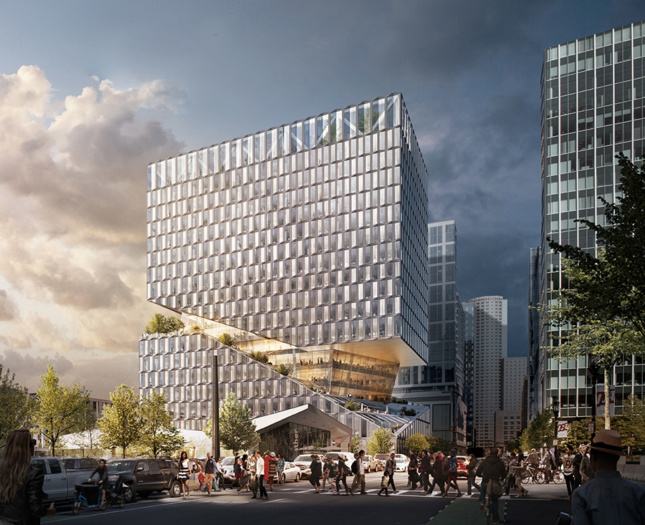
As one might expect, Boston is the center of most architectural activity in the region. Yet, despite a heroic postwar age of Brutalism, too much contemporary architecture barely rises above the level of commercial real estate. With the exception of Diller Scofidio + Renfro’s Institute of Contemporary Art and David Hacin’s District Hall, much of the frantic new downtown construction features the kind of glass boxes that pierce city skylines from Dubai to Shanghai. The city’s embarrassingly named Innovation District (often called the Inundation District due to its propensity for flooding) is scaleless, overbearing, and disconnected from the soul of Boston.
OMA ’s new scheme for the area—which the architects gratuitously refer to as “a dynamic and vibrant area that is quickly emerging as one of the most exciting neighborhoods and destinations in the country”—is an 18-story glass cube with the dreary moniker of 88 Seaport Boulevard. One might have hoped for more from OMA’s first Boston commission. The block will offer almost half a billion square feet of office space, 60,000 square feet of retail, and a paltry 5,000 square feet for civic and cultural use. Its gimmick is slicing the building into two sections with some terracing and plantings sandwiched in between. OMA disingenuously claims this double-volume exercise “creates diverse typologies for diverse industries,” and furthermore “generates an opportunity to draw in the district’s public domain.” In short, Boston will get an off-the-shelf dystopian nightmare.
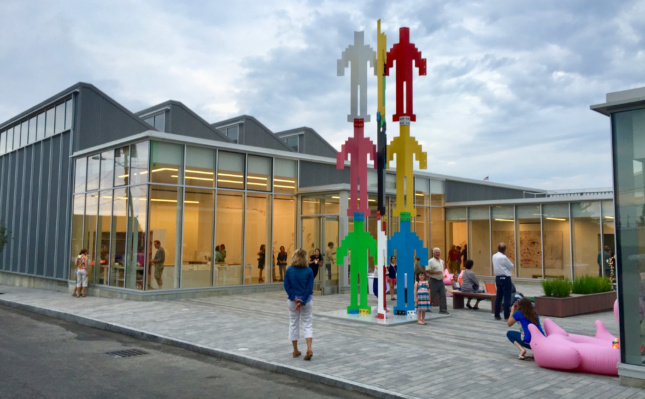
However, the Engineering Research Center at Brown University by KieranTimberlake is not just another knockoff. Although flush from the controversial but triumphant U.S. Embassy in London , the Philadelphians’ latest New England project is what good contemporary architecture ought to be. The $88-million, 80,000-square-foot laboratory and classroom building is both understated and environmentally responsible. Its 22 pristine labs steer the Ivy League school into uncharted territory in nano research, energy studies, and information technology.
The ERC is a triumph, especially given Brown’s decades of struggle to find an appropriate contemporary architectural voice. Recent work on the Providence campus includes an international relations institute by Rafael Viñoly—the design of which was dumbed down to mollify historic preservationists; a tepid Maya Lin sculpture; and an awkwardly sited Diller Scofidio + Renfro art center that was commissioned to show that Brown could do trendy and edgy. These common missteps are best exemplified by the university’s first competition for an athletic center. Although the competition was officially won by SHoP, the donor sponsoring it declared his dislike of modern architecture and demanded the school hire Robert A.M. Stern instead. The cutesy Georgian result is predictably bland.
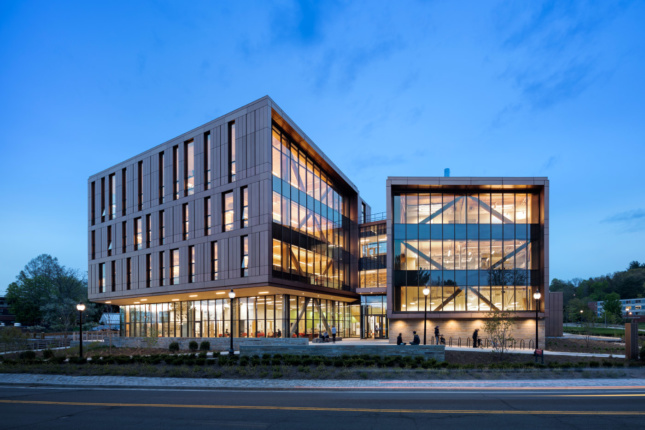
The ERC was ahead of schedule and under budget, and rather than treating Rhode Islanders as rubes, the architects created what Stephen Kieran calls “a nice piece of Providence urbanism.” While the firm’s great strength is diminishing the environmental impact of their buildings, the ERC also contributes a handsome facade to the campus’s traditional buildings. The fiberglass-reinforced concrete fins, the building’s signature element, impose a timeless probity worthy of Schinkel.
If KieranTimberlake grows weary of being identified as the designers of the $1-billion embassy that Trump slammed as “ lousy and horrible ,” imagine how tired Tod Williams and Billie Tsien must be of consistently being tagged with the label “ designers of the Obama Library .” Is a client choosing them because of the reflected fame? Will all new works by the New York-based architects be measured against that Chicago shrine? Yet Williams and Tsien have created a number of noteworthy academic works in New England that deserve similar attention, including buildings at Bennington and Dartmouth.
Their theater and dance building at Phillips Exeter Academy in Exeter, New Hampshire, is almost complete. Here, the very long shadow is not cast by the architects’ own projects, but by Louis Kahn’s library across campus. Kahn’s brick tribute to 19 th -century Yankee mills—and the symmetry of Georgian style—is one of the great pieces of architecture in New England. The big block of the drama building by Williams and Tsien wisely does not choose to echo Kahn but is curiously almost a throwback to the early Brutalism of I. M. Pei. It establishes a more rugged character with a marvelous texture composed of gray Roman bricks.
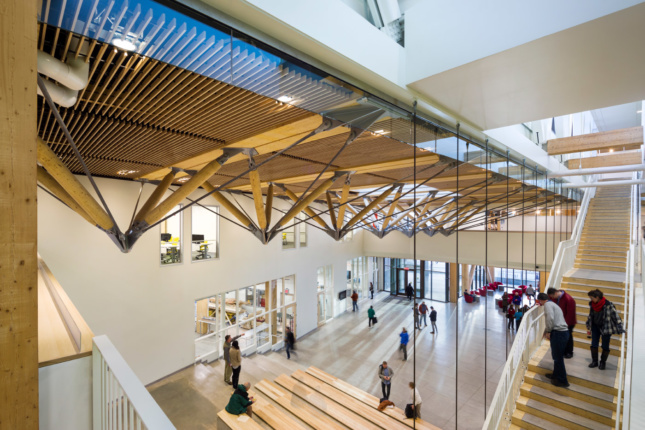
A more satisfying Granite State structure by Williams and Tsien is a library, archives, and exhibition complex at the MacDowell Colony in Peterborough, New Hampshire. MacDowell is a century-old artists’ colony where thousands of painters, writers, and musicians, including James Baldwin, Leonard Bernstein, Aaron Copland, and Willa Cather, have sought quiet and isolation in a collection of rustic cabins in the woods. Thornton Wilder wrote his classic play Our Town during his time here. Williams and Tsien’s sensitive addition to the colony’s 1920s library is only 3,000 square feet, cost around $2 million, and is an exquisitely crafted gem.
The single-story library is constructed of a nearly black granite. Set in a birch grove created by the leading modern landscape architects in Boston, Reed Hilderbrand , this gathering place for residents appears at one with the rocky soil and forests of Northern New England. A 23-foot-tall outdoor chimney flanking the entrance plaza to the library makes reference to the hearths in all of the MacDowell studios. It also looks like a primitive stele, giving the entire ensemble an aspect that is more primal than modern.
Another prominent New York architect, Toshiko Mori , has produced a simple yet elegant warehouse for an art museum in the faded seaport and art destination of Rockland, Maine . Built to house a long-time contemporary art cooperative that had no permanent collection and only inadequate facilities for exhibitions and classes, the saw-toothed clerestories at the Center for Maine Contemporary Art (CMCA) make reference to New England factories while bringing in what the architect calls “that special Maine light.” Like those functional structures, Mori used economical, non-custom materials such as plasterboard and corrugated zinc that wrap the exterior, embracing the lack of funds to her advantage.
Despite the nod to Rockland’s working class vibe, Mori created a thoughtfully wrought sophisticated work of art on an unremarkable side street. Mori’s Japanese heritage comes through in her subtle proportions based on a 4-foot grid. The CMCA offers a refreshing contrast to extravagantly costly new museums by superstar architects—the 11,000-square-foot arts center cost only $3.5 million. Mori has crafted a museum based on flexibility rather than attitude. A summer resident of nearby North Haven, she endowed her simple statement with an air of Yankee frugality.
But perhaps the most encouraging new project is the $52-million John W. Olver Design Building at the University of Massachusetts, Amherst. A cooperative venture of three departments in three different colleges—architecture, landscape, and building technology—the autumn-hued, aluminum-wrapped school embodies the dynamic spirit of New England’s first publicly supported architecture program.

The 87,000-square-foot studio and administrative space is the work of Boston–based Leers Weinzapfel and landscape designer Stephen Stimson , with contributions from the faculty-cum-clients. Construction Technology chair Alexander Schreyer, for example, a guru of heavy-timber structural systems, helped fashion what is perhaps the largest wood-frame building on the East Coast. The zipper trusses that span the 84-by-56-foot, two-story-high common area demonstrate the inventiveness of wood technology. The glulam trusses arrived on-site precut and were snapped together with pins. In short, the academic contributors got to show off their research and also benefit from it.
In a region noted for some of the nation’s oldest and most renowned design schools, the Design Building announces the arrival of the new kid on the block. Its handsome envelope is pierced by asymmetrically placed tall and narrow fenestration as a nod to the doors of the tobacco barns that are the university’s neighbors in Massachusetts’s Pioneer Valley.
From its roots as a fledgling offering in the art department in the early 1970s, design education at UMass has grown into a powerhouse. As the core of a complex of postwar and contemporary architecture, the Design Building helps to bring Roche Dinkeloo’s Brutalist Fine Arts Center into contact with a business school designed by the Bjarke Ingels Group (BIG). While BIG’s work is sometimes incredibly innovative, the firm’s UMass project looks as if it might be another example of a second-tier work foisted on a boondocks location. Less flashy than its newer neighbor, Leers Weinzapfel’s Design Building is nonetheless a bold, homegrown achievement.
New England’s patrimony is a tapestry of local and outside talent. A significant regional building would not be a postmodern structure in the shape of a lighthouse or a neotraditional re-creation of a Richardson library, but something like the UMass studios. Capturing the spirit of the best of New England design depends little upon reputation and huge expenditure. Rather, there is a direct correlation between realizing a quality work of art and understanding the region’s history of wresting a hard-won life from the granite earth. The challenge for successfully practicing architecture in New England is accepting an uncompromising intellectual toughness that demands respect for the eminently practical as well as the aspirational.

Shepley Bulfinch celebrates 150 years of practice with a new exhibition at the Boston Architectural College
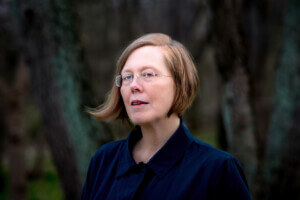
Billie Faircloth, former KieranTimberlake partner and research director, is joining Cornell AAP
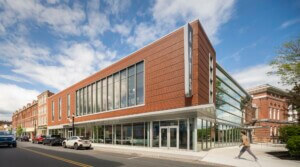
The Paul J. Schupf Art Center by Susan T. Rodriguez Architecture and Design steps off campus to bring town and gown together
- Phone: (978) 256-2001
- Fax: (978) 256-2002
- Email: [email protected]

CCS Presentation Systems
Audio visual services.

AV Sales & System Integration
From simple installations to complex integration projects, CCS has the knowledge and experience to outfit your space.

Design Engineering
To ensure that our clients get the most out of their systems, we have an in-house team of seasoned industry engineers ready to produce high-quality designs.

Project Management
We understand the importance of getting your AV projects completed on time and within budget. Our project management team will ensure your AV installation is completed within your timeline and to your satisfaction.

AV Installation
The key to delivering quality audio visual service is a proper installation from professionals you can trust. Our technicians have extensive experience, ensuring your job is completed quickly and efficiently.

AV Training
After the install, let CCS train your team so your new equipment is utilized and appreciated.
Audio Visual Solutions

AV Furniture

Conferencing Systems
Digital Signage

Interactive & Collaborative Solutions

Microphones & Voice Systems

Projectors & Screens

Room Control Systems

Temperature Check Tablets

Video Walls
Audio/video conferencing systems.

LED/LCD Displays
Safety solutions (temp kiosk, bells, safe system).

Our Markets

K12 Education

Higher Education

Hospitality Entertainment

Client Testimonials

Featured Brands

Let's Talk About Your AV Needs.

- 978-256-2001
- [email protected]
Useful Links
- Testimonials
- Contracts & Certifications
- Career Opportunities
Contact Info
MA Office : 444 Washington Street Suite 406 Woburn, MA 01801
- MHEC: MC15-B11
- NY OGS 38806
- NY OGS 20915
Copyright 2023 CCS Presentation Systems ( CCS New England ) | Privacy Policy | Terms & Conditions | Sitemap.xml
- Support NEP
- Upcoming Events
- Professional Development Fund Information
- Benefits of Membership
- Annual Report
%20(3000%20x%20750%20px).png)

Crop your artwork:
Scan your QR code:
Gratefully built with ACNLPatternTool
Presentation vase
New England Glass Company American
On view at The Met Fifth Avenue in Gallery 704
Depictions of glasshouses on glassworks are rare. The engraving on this important presentation vase depicts the New England Glass Company with the chimneys of its three furnaces—two for glass and one for lead. The inscription “From / Henry Whitney / to / Thomas Leighton / East Cambridje / August 1843 / A token of grateful remembrance” highlights two notable figures of the New England Glass Company, Henry Whitney and Thomas Leighton. The vase was presented to Leighton on Whitney’s retirement from the firm in 1843.
to experts illuminate this artwork's story
#4521. Presentation vase
Your browser doesn't support HTML5 audio. Here is a link to download the audio instead.
Due to rights restrictions, this image cannot be enlarged, viewed at full screen, or downloaded.
Open Access
As part of the Met's Open Access policy , you can freely copy, modify and distribute this image, even for commercial purposes.
Public domain data for this object can also be accessed using the Met's Open Access API .
- https://www.metmuseum.org/art/collection/search/9173 https://www.metmuseum.org/art/collection/search/9173 Link copied to clipboard
- Animal Crossing
- Download image
- Enlarge image

This artwork is meant to be viewed from right to left. Scroll left to view more.
Artwork Details
Use your arrow keys to navigate the tabs below, and your tab key to choose an item
Title: Presentation vase
Maker: New England Glass Company (American, East Cambridge, Massachusetts, 1818–1888)
Geography: Made in East Cambridge, Massachusetts, United States
Culture: American
Medium: Blown, cut, and engraved glass
Dimensions: H. 13 in. (33 cm)
Credit Line: Purchase, Judith F. and William H. Hernstadt Gift, and Robert G. Goelet Gift, 1980
Accession Number: 1980.69
Learn more about this artwork
Timeline of art history, the united states and canada, 1800-1900 a.d., museum publications.
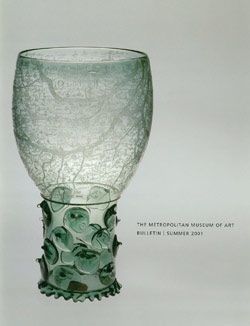
_Ars Vitraria_: Glass in The Metropolitan Museum of Art

The American Wing at The Metropolitan Museum of Art
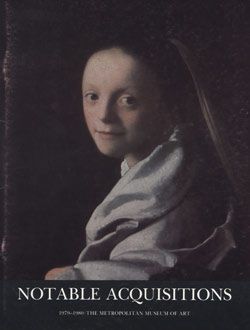
Notable Acquisitions, 1979–1980
Related artworks.
- All Related Artworks
- In the same gallery
- By New England Glass Company
- The American Wing
- Blown glass
- From Cambridge
- From East Cambridge
- From Massachusetts
- From North and Central America
- From United States
- From A.D. 1800–1900
Finger Bowl
Cut glass shade
Resources for Research
The Met's Libraries and Research Centers provide unparalleled resources for research and welcome an international community of students and scholars.
The Met Collection API is where all makers, creators, researchers, and dreamers can connect to the most up-to-date data and public domain images for The Met collection. Open Access data and public domain images are available for unrestricted commercial and noncommercial use without permission or fee.
We continue to research and examine historical and cultural context for objects in The Met collection. If you have comments or questions about this object record, please complete and submit this form . The Museum looks forward to receiving your comments.

The American Wing at The Met

Literature in the American Renaissance The Flowering of New England 1840-1860
Mar 29, 2019
210 likes | 509 Views
Literature in the American Renaissance The Flowering of New England 1840-1860. Transcendentalists Anti-transcendentalists Brahmins Fireside Poets. Characteristics of Period. Rush of optimism characterized American expansion, reform, and literature
Share Presentation
- american renaissancethe flowering
- new englanders
- emily dickinson
- literate family circle
- inner potential

Presentation Transcript
Literature in the American RenaissanceThe Flowering of New England1840-1860 Transcendentalists Anti-transcendentalists Brahmins Fireside Poets
Characteristics of Period • Rush of optimism characterized American expansion, reform, and literature • Technological increases + increase in reading audience = increased opportunities for writers • American literature achieved a “universal voice”
Emerson (Concord) Thoreau (Concord) Hawthorne (Salem) Melville (Pittsfield) Longfellow (Cambridge) Whittier (Haverhill and Amesbury) Holmes (Cambridge) Lowell (Cambridge) Dickenson (Amherst) Massachusetts home of 8 of these writers Boston touched most of their lives, but names are often associated with smaller towns Major writers of the time
Transcendentalism • Roots in Boston and Cambridge in 1830s • Western branch in STL in 1840s • Parted from philosophies of John Locke who asserted that knowledge comes from the outside, through our senses (tabula rasa)
During 18th century (1700s), Locke’s idea that knowledge must derive from 5 senses dominated • 1800s transcendentalism asserts that knowledge comes from beyond our senses • Humanism + Naturalism + Soul
Transcendentalism • Neither a religion nor a philosophy nor a literary theory (elements of all 3) • Knowledge comes from inside (intuition) and not from our senses • The “God in us” • All humanity knows how to behave if we trust our inner light • Don’t look to the past, but rather within • Literature has no fixed idea, genre, or structure
Transcendentalism • Because knowledge is within the self, one does not need the past, the family, or the society as guides to behavior • Radical Individualism • Self transcends and when left to human nature, goodness will prevail
Insisted one should follow one’s instinct wherever it leads, irrespective of convention Do whatever one wants deeply to do Great American literature would arise not by following the forms and language of other cultures, but by writing about American things in and American landscape Nation, like the individual, must realize itself Emerson and Thoreau
Emerson • “[Intuition] never reasons, never proves, it simply perceives” • “highest power is the soul” • Similar to Puritan views of experiencing God; but, very different in the sense Emerson believed ALL could experience God firsthand (not reserved for “elect” few) • Over-soul---drives everything in nature to realize its inner potential
Thoreau • Took transcendentalist ideas and his naturalist talents to create Walden • Weaves together natural, human, and spiritual meanings • Nature is the means to self-knowledge
Anti-transcendentalists • Attacked transcendentalists for ignoring 2 powerful realities: reality of evil and reality of human love • Argue transcendentalism rests on humanity’s goodness---but when left to its own devices, why would humanity behave well?
Anti-transcendentalists • Wondered if a self freed from society might be freed only to release violence and chaos • Humans can’t escape conscience, institutions, or the past since they arose from deep emotional needs • Unbridgeable gap between human desires • Mixture of good and evil in all human motives
Hawthorne and Melville • Not all humanity is good • Think about Hawthorne’s commentary on society in The Scarlet Letter • People are seekers of truth, not finders of it • Humanity, while it might be good, is restricted by dark forces that it cannot control
Hawthorne and Melville • People can be not only reasonable but also unpredictable, unreasonable, & filled with self-conceit • Over-emphasis on the individual will lead to destruction • The self we display to the world is no different than the inner self • Harsh industrial conditions, slavery, and the Civil War seem to invalidate transcendentalism
Fireside Poets • Longfellow, Whittier, Holmes, and Lowell • Shared common themes and techniques • Poetry deals mainly with nature, family, and mythical material • Relatively easy to read for the “literate family circle” of the time as well as scholars
Brahmins • “brahmin” is reference to highest caste in Hindu society • Lowell, Longfellow, and Holmes were considered high caste New Englanders • Represented good taste and distinguished achievements • Unaffected by transcendentalist movement
Emily Dickinson • Also a poet during this time period • Works were largely unpublished during this time though
“American Actuality” • Anti-transcendentalists’ assertion of uneven balance within humans as opposed to the transcendentalist optimism • The times reflect the truth of Hawthorne and Melville, not Emerson and Thoreau • Both optimism in human possibilities and appraisal of human limits were needed for American literature to fully mature.
- More by User

American Transcendentalist Literature 1840-1855
American Transcendentalist Literature 1840-1855. A new philosophy: Transcendentalism. Began in the 1840’s Literary Movement influenced by the German philosopher, Immanuel Kant Concentrated in New England – called the New England Renaissance
1.12k views • 16 slides

New England Renaissance
New England Renaissance. The First Major Literary Period in America. New England Renaissance 1830’s - 1850’s Called the American Renaissance if including Poe and others Northeasterners include Emerson, Thoreau, Hawthorne, Melville, Fireside poets, and Whitman. Transcendentalism
790 views • 11 slides
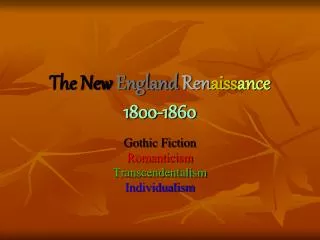
The New England Ren aiss ance 1800-1860
The New England Ren aiss ance 1800-1860. Gothic Fiction Romanticism Transcendentalism Individualism. Gothic Fiction – POE!. Mystery Suspense Horror Symbolism Edgar Allan Poe – Father of the Short Story 1809 birth in Boston, mother died in 1811, taken in by Allan family.
283 views • 9 slides

1840 - 1860
1840 - 1860 . A Clustering of Innovation. Let the Clustering Begin!. 1841 Calotype (Talbot) 1842 Cyanotype (Herschel) 1840’s Albumen (Talbot, Niepce, Blanquart- Evard) 1851 Collodion (Archer) 1850’s Ambrotype (Archer, Fry) 1853 Tintype (Martin) 1856 Oxymel (Llewelyn).
434 views • 10 slides
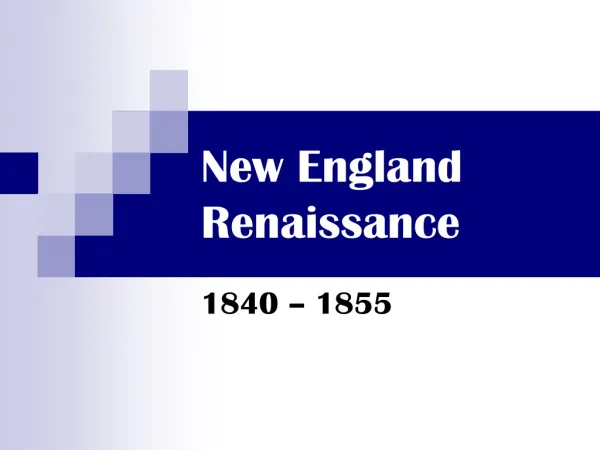
New England Renaissance. 1840 – 1855. Review. America is growing New states and population increase Transportation growth Literary growth Romantic Period – 1800-1840 Favor imagination over reason and intuition over facts Intense interest in nature. Introduction. Population still growing
437 views • 21 slides
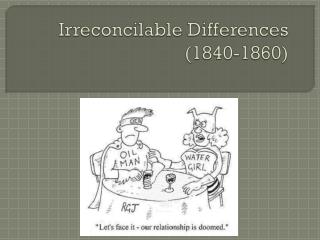
Irreconcilable Differences (1840-1860)
Irreconcilable Differences (1840-1860). Slavery. Slavery. The South in Antebellum America was dominated by the planter-slaveholder class. Nearly 2/3 of the population DIDN’T own slaves.
116 views • 0 slides
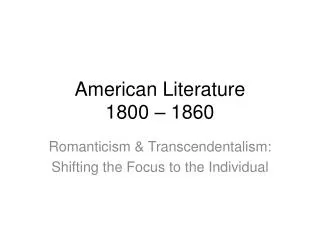
American Literature 1800 – 1860
American Literature 1800 – 1860. Romanticism & Transcendentalism: Shifting the Focus to the Individual. American Romanticism 1800-1860. The Industrial Revolution brought economic growth to the United Sates, and it transformed American society. Hundreds of new factories were built
860 views • 20 slides

American Literature: 1840-1860 TRANSCENDENTALISM
American Literature: 1840-1860 TRANSCENDENTALISM . American History. Tension leading to Civil War Slavery Westward expansion—railroads, telegraph Mexican War (1848) Industrialization . American Mind-Set. Increased roles of gov’t, increase in industrial productivity
991 views • 43 slides
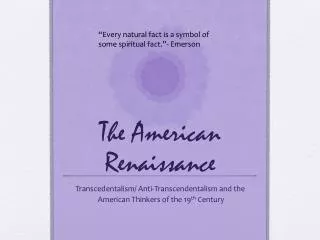
The American Renaissance
“Every natural fact is a symbol of some spiritual fact.”- Emerson. The American Renaissance. Transcedentalism / Anti-Transcendentalism and the American Thinkers of the 19 th Century.
271 views • 15 slides

Realism in American Literature 1860-1900
Realism in American Literature 1860-1900 .
460 views • 8 slides
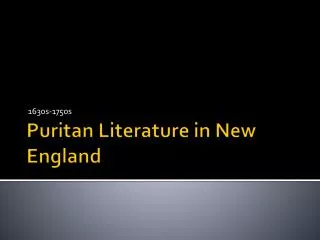
Puritan Literature in New England
1630s-1750s. Puritan Literature in New England. What’s a Puritan?. Puritans known as the Separatists split from the Church of England over disagreements and came to New England for religious freedom Allegiance to God/the group, not the king
382 views • 11 slides
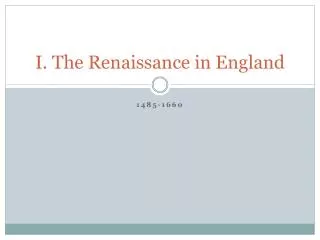
I. The Renaissance in England
I. The Renaissance in England. 1485-1660. A. The Protestant Reformation. Henry VIII – break with Rome (1534) Creation of English identity English Adaptation of Italian models - Sir Thomas Wyatt and Henry Howard. B. Succession – Tudor Dynasty. Henry VIII (1509-1547) Edward VI (1547-1553)
270 views • 10 slides

The American Renaissance: 1840-1860
The American Renaissance: 1840-1860. Transcendentalism & Anti -Transcendentalism. Transcendentalism. The optimistic view that God, the universe and the individual are all connected in one Universal soul with people and human nature as good and pure
329 views • 10 slides
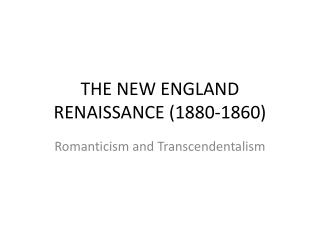
THE NEW ENGLAND RENAISSANCE (1880-1860)
THE NEW ENGLAND RENAISSANCE (1880-1860). Romanticism and Transcendentalism. Background Information. Follows the Enlightenment Thinkers Stressed objectivity Use of the senses Removal of the “unexplainable Removal of knowledge based on belief Power of Reason to discover laws of the universe
470 views • 22 slides
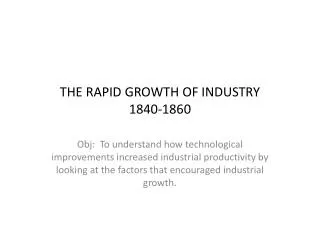
THE RAPID GROWTH OF INDUSTRY 1840-1860
THE RAPID GROWTH OF INDUSTRY 1840-1860. Obj : To understand how technological improvements increased industrial productivity by looking at the factors that encouraged industrial growth. THE INDUSTRIAL NORTH TECHNOLOGY: application of science to improving conveniences of life - 1829.
255 views • 9 slides
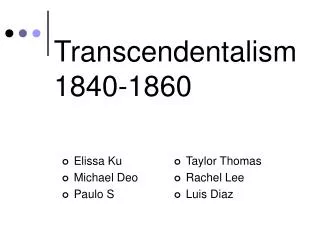
Transcendentalism 1840-1860
Elissa Ku Michael Deo Paulo S. Taylor Thomas Rachel Lee Luis Diaz. Transcendentalism 1840-1860. Objective. To understand the historical background that led to Transcendentalism To identify the styles of Transcendentalism To analyze Transcendentalism works. Transcendentalism.
595 views • 12 slides

Immigration 1840 – 1860
208 views • 12 slides

The Renaissance Period 1840-1860
The Renaissance Period 1840-1860. Renaissance Period. Distinct period of Romantic Period Was a ‘ rebirth ’ / coming of age Illustrated By American writers Finding their own identity Moving away from English literature and influences. Renaissance Period.
477 views • 24 slides

American Literature: 1840-1860 TRANSCENDENTALISM. American History. Tension leading to Civil War Westward expansion—railroads, telegraph Mexican War (1848) Industrialization. American Mind-Set. Dissatisfaction with present time, optimism about future
314 views • 13 slides

THE AMERICAN RENAISSANCE
THE AMERICAN RENAISSANCE. A Literary Coming of Age 1840 - 1860. English Critic – Sydney Smith. Literature…the Americans have none…in the four corners of the globe, who reads an American book?!. True American Literary Giants Emerge. Herman Melville Nathaniel Hawthorne Ralph Waldo Emerson
256 views • 16 slides

The American Renaissance. A literary coming of age 1840-1860. The American Renaissance. In the mid 1800’s, it was not clear whether America would ever produce a writer as good as William Shakespeare .
92 views • 8 slides

Anti-Transcendentalism 1840-1860
Anti-Transcendentalism 1840-1860. Reasons and Causes. Opposed the optimism and naïve idealism of the transcendentalists Dwelt on guilt and remorse over past sins
84 views • 8 slides
.css-1ytbthu{display:-webkit-box;display:-webkit-flex;display:-ms-flexbox;display:flex;-webkit-flex-direction:column;-ms-flex-direction:column;flex-direction:column;-webkit-box-flex-wrap:wrap;-webkit-flex-wrap:wrap;-ms-flex-wrap:wrap;flex-wrap:wrap;} .css-o21ktk{margin-bottom:8px;}.css-o21ktk:last-of-type{margin-bottom:0px;} .css-1u8zn73{font-size:0.75rem;text-transform:uppercase;color:var(--theme-ui-colors-readablePrimary);} Press .css-1xlxmxt{margin-bottom:4px;} Showcase Cinema de Lux at Legacy Place celebrates Star Wars Day with exclusive New England presentation of The Skywalker Saga May The 4th Marathon .css-1ik693{font-size:0.875rem;font-weight:normal;} Friday, May 3, 2024 at 12:00 AM

Fans are Invited to Watch All Nine “Star Wars” Movies on the Big Screen on “Star Wars Day” beginning at 8:00 p.m. on May 3 until 6:45 p.m. on May 4; In-Lobby Offerings Include
Yoda Yoga, Refresh Stations, Special Concessions, Photo Ops and More
Norwood, MA, March 22, 2024 - Showcase Cinemas, a world leader in the motion picture exhibition industry, announced today that Showcase Cinema de Lux at Legacy Place in Dedham, Mass., will be one of only 14 theaters nationwide, and the only location in New England, to host the exclusive “The Skywalker Saga May the 4th Marathon” taking place May 3-4, 2024. Scheduled over “Star Wars Day” (May the 4th), Star Wars fans will have the opportunity to view all nine films from the Star Wars saga together on the big screen during a 23-hour time period, including a special look at the upcoming Disney+ series “The Acolyte.”
Tickets are on sale now, priced at $40 for the general public and $35 for Starpass loyalty program members. Tickets can be purchased via the Showcase Cinemas website at this link. Tickets include all nine movies and exclusive commemorative items including a limited-edition collectible print and a keepsake marathon badge. Marathon guests will also receive a 25 percent discount on food and beverage purchases (excluding alcohol), including on items featured on the special Star Wars-themed menu.
“The Skywalker Saga May the 4th Marathon” begins with “Star Wars: Episode I - The Phantom Menace” at 8 p.m. on May 3 and concludes with “Star Wars: Episode IX - The Rise of Skywalker,” ending at 6:45 p.m. on May 4. Short breaks will be offered in between films for guests to freshen up and purchase food. The morning breakfast break will include Yoda yoga to help guests stretch between films; marathon attendees will also enjoy a special stormtrooper photo op in the lobby.
“What better way to celebrate May the 4th this year than to watch all of the ‘Star Wars’ films on the big screen back-to-back?” said Mark Malinowski, Vice President of Global Marketing at Showcase Cinemas. “This is definitely a once-in-a-lifetime opportunity for Star Wars fans to celebrate the day in a big way, and we couldn’t be more excited to help them create special memories with activations like Yoda yoga, our stormtrooper photo op, themed concessions and more. It’s going to be an incredible event!”
Showcase Cinema de Lux at Legacy Place is one of the most technologically innovative and advanced entertainment destinations in the country. The theater features the only XPlus premium large format auditorium with dual-laser projection, along with all-reserved, fully powered recliners, upgraded sound systems and laser projection in all 15 auditoriums. The lobby offers a wide array of Starbucks® coffee options, craft cocktails and a gourmet food menu, along with a fleet of Coca-Cola Freestyle machines offering nearly 200 flavor combinations, a giant digital screen and a state-of-the-art box office.
ABOUT SHOWCASE CINEMAS Showcase Cinemas is a world leader in the motion picture exhibition industry, operating nearly 800 movie screens in the U.S., U.K., Argentina and Brazil under the Showcase, Cinema de Lux, SuperLux and UCI brands. With 21 theater locations in the United States, Showcase Cinemas delivers the finest entertainment experience, offering the best in viewing, comfort and dining. For more information about Showcase Cinemas please visit our website at www.showcasecinemas.com.
Massachusetts town blindsided by governor turning former prison into migrant shelter
by JULIAN BARON | The National Desk

NORFOLK, Mass. (TND) — Officials in a Massachusetts town are concerned after Gov. Maura Healey revealed plans to turn a former prison into an emergency migrant shelter.
The town of Norfolk, Mass. was notified Friday that Bay State Correctional Center, a decommissioned state prison, would become a "temporary emergency shelter" under orders from the Healey administration, town officials say.
This decision was made as part of its ongoing response to the number of migrant families arriving in Massachusetts. The Town had no role in this decision and was not consulted prior," Norfolk leaders said in a statement.
Massachusetts is one of many Northeast states that have struggled to accommodate an influx of migrants arriving from the southern border and elsewhere. Gov. Healey sparked protests in Boston last week when she signed a law sending millions of additional dollars to the state's emergency shelter system.
Norfolk officials say the arrival of migrant families "poses many logistical challenges" to the town, which is home to about 12,000 residents. Local leaders are working on a list of ways the migrant arrivals will impact the town and strategies for mitigating those impacts.
We also will have regular conversations with state officials to ensure the Town’s concerns are heard, and to work collaboratively on creative solutions that are in the best interests of Norfolk," town officials said.
A spokesperson for Gov. Healey did not respond to a request for comment from The National Desk on Monday.
Massachusetts is the only state in the country that guarantees housing to all residents under a "right to shelter" law. Some local jurisdictions, such as New York City, have also passed "right to shelter" provisions. Like Massachusetts, New York City is struggling to manage an ongoing surge of migrant arrivals.
Got a story idea or news tip? Reach out to Julian Baron on X or via email at [email protected].

IMAGES
VIDEO
COMMENTS
New England, region, northeastern United States, including the states of Maine, New Hampshire, Vermont, Massachusetts, Rhode Island, and Connecticut.. The region was named by Capt. John Smith, who explored its shores in 1614 for some London merchants.New England was soon settled by English Puritans whose aversion to idleness and luxury served admirably the need of fledgling communities where ...
13 Colonies. Life in early America. Objectives/Standards: . Describe the contributions of geographic and economic conditions, religion, and colonial systems of government to the development of American democratic practices. Describe the geography, cultures, and economics of the Southern, Middle Atlantic, and New England Colonies.
The history of the New England colonies reflects the two-sided history of America as a whole. Native and immigrant cultures came together to create the modern United States, but also clashed in devastating conflict. While Native Americans and English settlers in the New England territories first attempted a mutual relationship based on trade ...
Introduction • New England is a region of the United States located in the north-eastern corner of the country. • It comprises the states of Connecticut, Maine, Massachusetts, New Hampshire, Rhode Island, and Vermont. New England's flag • The region's most packed city, as well as its business and cultural center, is Boston.
What are the New England Colonies? The 13 colonies of North America that later became the United States of America can be divided into three geographic areas: the New England, Middle, and Southern colonies. The New England colonies were the northernmost of the colonies: These included. New Hampshire, Massachusetts, Rhode Island, and Connecticut.
Oct 9, 2007 • Download as PPT, PDF •. 4 likes • 3,929 views. AI-enhanced description. D. DebbyP. The document provides an overview of New England's geography, history, society, religion, economy, and government in the colonial period. It notes that the region had thin, rocky soil and long, harsh winters that made farming difficult.
The 13 Colonies. The 13 colonies all were all on the east coast of America but they were all discovered at different times and for different reasons. The New England Colonies. Today you will learn about the New England Colonies. For further reference you can review this video: New England Colonies.
Document presentation format: On-screen Show (4:3) Other titles: Arial Times New Roman Wingdings Default Design New England Colonies (1620-1700) Two Dominant Religions In England Major Religions In Europe (ca. 1560) Pilgrims Land At Plymouth (November, 1620) First Thanksgiving (1621) Massachusetts Bay Colony (1630) Great Puritan Migration (1610 ...
The New England Colonies - Download as a PDF or view online for free. The New England Colonies - Download as a PDF or view online for free. Submit Search. Upload. The New England Colonies ... Massachusetts colony presentation updated Peggy Bloomer ...
Although flush from the controversial but triumphant U.S. Embassy in London, the Philadelphians' latest New England project is what good contemporary architecture ought to be. The $88-million ...
Historic New England is soliciting student and recent graduate poster presentations for the 2022 Historic New England Summit to be held at Mechanics Hall in Worcester, MA, October 13-14, 2022. The region's largest multi-disciplinary event will assemble provocative, informative and collaborative experts for a highly interactive conversation ...
In 1620 one of the separatist congregations sailed for New England on the Mayflower. The ship sailed from Plymouth, England, on September 16, 1620, with 102 passengers, including 32 children. Two people died, two were born. The ship was headed for Virginia, where the colonists had been authorized to settle.
New England Colonies PPT - Free download as Powerpoint Presentation (.ppt / .pptx), PDF File (.pdf), Text File (.txt) or view presentation slides online. PPT of the development and beginnings of the New England Colonies
Historic New England Example: Eustis Estate. Shingle Style: 1880 - 1900. Unlike preceding architectural styles, the Shingle Style is not defined by applied decoration and therefore there is little in the way of applied detailing at the doors, windows, cornices, porches, or on wall surfaces of Shingle Style homes. Instead, the focus of the ...
The New England Colonies included: Massachusetts, Connecticut, Rhode Island, and New Hampshire. The climate included longer, colder winters in comparison to the other winters. The soil in New England was very rocky, making it very hard to plant crops. It did however, have lots of trees, which gave the citizens lots of lumber and wood for ...
Download Free and Premium New England PowerPoint Templates. Choose and download New England PowerPoint templates, and New England PowerPoint Backgrounds in just a few minutes.And with amazing ease of use, you can transform your "sleep-inducing" PowerPoint presentation into an aggressive, energetic, jaw-dropping presentation in nearly no time at all.
New England Society (Education and Literacy) • Literacy • 90% men • 40% women • Other colonies: It was no more than 50% • In England: 33% could read and write. New England Society (Community Life) • Centered around the meeting house • Homes were close to one another • Farms • Originally communal • Later owned by individuals.
Disagreements about religion led to the founding of other New England colonies. New Hampshire • New Hampshire (1638)-was founded by John Wheelwright when he was forced to leave M.B.C. Mostly for religious freedom. • Wheelwright was a Puritan minster who got kicked out of M.B.C. for defending Anne Hutchinson • Exports-Furs, Cattle & Ships.
Regarding CCS New England's Meeting Spaces: "I have used CCS Presentations for two separate meetings, and found their space to be absolutely top-notch. The diversity of presentation and meeting tools available to me was incredible, and the meeting space itself is incredibly versatile.
Now is the time to extend your commitment to regional arts presenting by joining or renewing your membership with New England Presenters, a consortium providing leadership and support for the presentation and development of the performing arts in Connecticut, Maine, Massachusetts, New Hampshire, Rhode Island, and Vermont. Find Out How.
In 1620 one of the separatist congregations sailed for New England on the Mayflower. The ship sailed from Plymouth, England, on September 16, 1620, with 102 passengers, including 32 children. Two people died, two were born. The ship was headed for Virginia, where the colonists had been authorized to settle.
The engraving on this important presentation vase depicts the New England Glass Company with the chimneys of its three furnaces—two for glass and one for lead. The inscription "From / Henry Whitney / to / Thomas Leighton / East Cambridje / August 1843 / A token of grateful remembrance" highlights two notable figures of the New England ...
New England Renaissance. New England Renaissance. 1840 - 1855. Review. America is growing New states and population increase Transportation growth Literary growth Romantic Period - 1800-1840 Favor imagination over reason and intuition over facts Intense interest in nature. Introduction. Population still growing. 437 views • 21 slides
Showcase Cinema de Lux at Legacy Place celebrates Star Wars Day with exclusive New England presentation of The Skywalker Saga May The 4th Marathon . Fans are Invited to Watch All Nine "Star Wars" Movies on the Big Screen on "Star Wars Day" beginning at 8:00 p.m. on May 3 until 6:45 p.m. on May 4; In-Lobby Offerings Include
NORFOLK, Mass. (TND) — Officials in a Massachusetts town are concerned after Gov. Maura Healey revealed plans to turn a former prison into an emergency migrant shelter. The town of Norfolk, Mass. was notified Friday that Bay State Correctional Center, a decommissioned state prison, would become a "temporary emergency shelter" under orders from the Healey administration, town officials say.
This is the third time that Malmo, a city of 360,000 people on Sweden's southwest coast, has hosted the Eurovision Song Contest. In the last 30 years, the city has undergone a transformation to ...